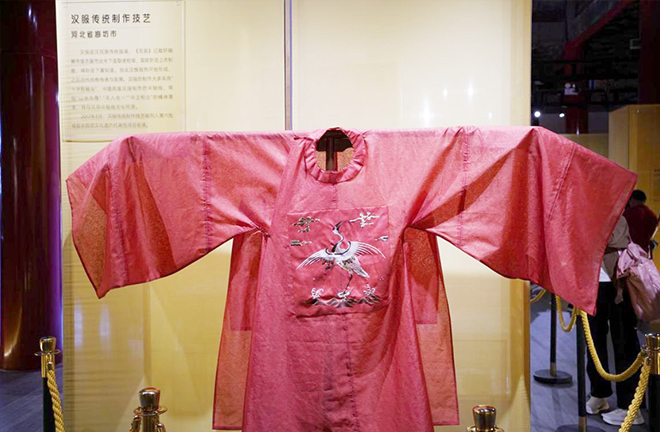Seminar eyes protection of intangible cultural heritage

A Han Chinese garment on display at an exhibition showcasing traditional weaving, dyeing, and embroidery in Beijing Photo: Yang Lanlan/CSST
JI’NAN—A forum on the sustainable development of intangible cultural heritage (ICH) was held in Ji’nan, Shandong Province, in early November. Participating scholars and experts expounded on the Chinese wisdom, experience, and solutions of ICH protection.
Institutional protection
Wang Chenyang, director of the Department of Intangible Cultural Heritage of the Ministry of Culture and Tourism, noted that China’s approach to ICH protection is based on the inheritance and achievements in protecting ethnic and folk traditional culture within the framework of the UNESCO Convention for the Safeguarding of the Intangible Cultural Heritage (hereinafter referred to as the Convention).
Huang Yonglin, former vice president of Central China Normal University (CCNU) and a professor from the Intangible Cultural Heritage Research Center at CCNU, believes that China’s achievements in ICH protection are largely attributable to a series of effective institutional construction measures. Specifically, these measures include building a representative list system, formulating the identification and management rules of representative inheritors, initiating a system of cultural and ecological conservation areas, establishing special organizations for the purpose of management, and promulgating the Intangible Cultural Heritage Law of the People’s Republic of China. ICH is thereby “brought to life” through productive protection in practice and made “prevalent” via rational usage.
Cultural dialogue
Since China’s accession to the Convention in 2004, it has diligently fulfilled its obligations as a contracting party. To date, China has entered the Representative List of the Intangible Cultural Heritage of Humanity, the List of Intangible Cultural Heritage in Need of Urgent Safeguarding, and the Register of Good Safeguarding Practices, inscribing a total of 43 ICH practices, ranking first in the world. Bamo Qubumo, a research fellow from the Institute of Ethnic Literature at the Chinese Academy of Social Sciences (CASS), who has long participated in UNESCO’s ICH protection work, explained how China has strengthened systematic ICH protection through international cooperation mechanisms centering on the listing and periodic reporting mechanisms within the framework of the Convention. The application for inclusion in the world heritage list has facilitated the integration of China’s rich and diverse traditional culture into the international community, fostering deeper exchanges and mutual learning among civilizations and contributing to the development of a human community with a shared future.
In the view of An Deming, deputy director of the Institute of Literature at CASS, the concept of “intangible cultural heritage,” which emerged from the collaborative efforts of various countries, has, after more than 20 years of development, introduced a new status and mode of survival for the specific and diverse cultures it encompasses. It offers a fresh approach and perspective for understanding these cultures and addressing cultural, group, and ethnic relations. By facilitating mutual understanding and tolerance among different cultures and reducing cultural estrangement and conflicts, ICH serves to establish a more harmonious and united international cultural order.
Ways forward
ICH constitutes an integral part of China’s fine traditional culture, a vivid witness of the continuous Chinese civilization, and a major basis for maintaining national sentiment and unity. In the process of Chinese modernization, ICH protection is undertaking new missions.
At present, China’s ICH protection has ushered in a new stage of systematic protection. Shahbaz Khan, director of UNESCO Multisectoral Regional Office for East Asia, highlighted the necessity of integrating ICH protection into comprehensive policies, not only in the field of culture, but also in many other areas of sustainable development, such as agriculture, health, economic development, and climate change. Furthermore, systematic ICH protection can only be achieved through the effective cooperation of stakeholders, including the government, communities, professional centers, research institutions, and civil society.
Liu Kuili, a CASS Member, called for more attention to non-materiality using deconstruction and structure methods, the interaction between the “subject of agency” as the core of ICH inheritance and the “subject of audience,” and the continuity and dynamic life of ICH. In addition, greater importance should be attached to spatiality or the multi-dimensional, holistic review of real-life ICH, practicality or ICH protection as cultural practices, as well as value orientations or the excavation of rich emotional connotations behind ICH.
Based on the analysis of the function and evolution of human language and culture, Chao Gejin, a CASS Member, stressed the importance of oral tradition research in ICH protection. The performance of oral traditions by folk artists plays a vital role in transmitting knowledge, cultural and social values, and collective memory, as well as in maintaining the vitality of culture.
The conference was co-hosted by Shandong University and Shandong Provincial Department of Culture and Tourism under the guidance of the Department of Intangible Cultural Heritage of the Ministry of Culture and Tourism.
Edited by YANG LANLAN
